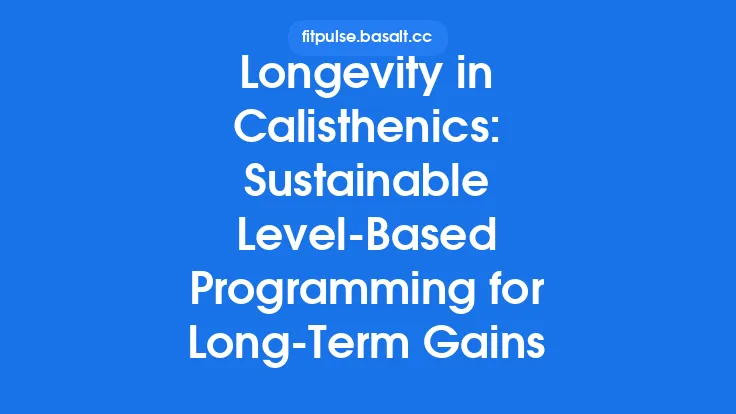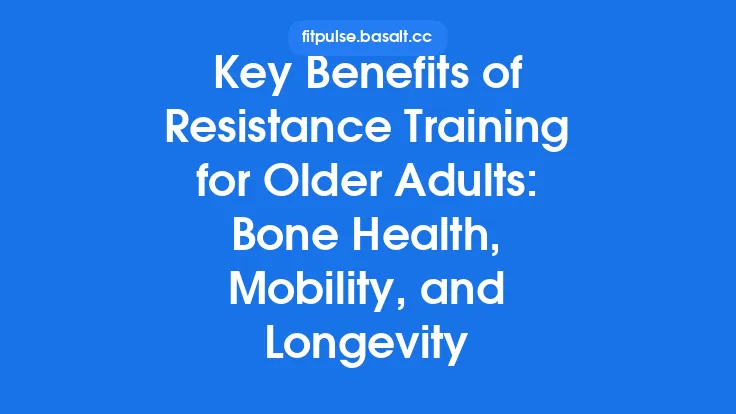Holistic wellness is more than a collection of isolated exercises; it is a deliberate orchestration of movement, breath, and body awareness that supports the body’s ability to age gracefully. When yoga, mobility work, and calisthenics are woven together, they create a synergistic platform that addresses flexibility, joint health, muscular strength, and neuromuscular coordination—all critical pillars for longevity. This article explores the physiological underpinnings of each discipline, outlines how they complement one another, and provides a framework for integrating them into a cohesive, lifelong practice.
The Science of Longevity: How Movement Influences Aging
Research across gerontology and exercise physiology consistently shows that regular, varied movement can attenuate many age‑related declines:
| Physiological System | Age‑Related Change | Protective Effect of Movement |
|---|---|---|
| Musculoskeletal | Loss of muscle mass (sarcopenia) and bone density (osteopenia) | Resistance‑type loading (e.g., calisthenics) stimulates muscle protein synthesis and osteogenic stress, preserving lean mass and bone strength. |
| Connective Tissue | Decreased collagen elasticity, joint stiffness | Dynamic stretching and joint‑centric mobility drills maintain collagen turnover and synovial fluid circulation. |
| Cardiovascular | Reduced maximal oxygen uptake (VO₂max) | Whole‑body rhythmic movement (as in yoga flows) improves endothelial function and capillary density. |
| Nervous System | Decline in proprioception and motor unit recruitment | Complex motor patterns in calisthenics and yoga enhance neuroplasticity and motor unit synchronization. |
| Metabolic | Insulin resistance, reduced mitochondrial efficiency | Repeated bouts of moderate‑intensity activity improve glucose uptake and mitochondrial biogenesis. |
The convergence of these adaptations creates a “physiological reserve” that enables the body to cope with stressors, recover more efficiently, and maintain functional independence well into later decades.
Yoga: Foundations of Flexibility, Balance, and Breath
Yoga is a millennia‑old practice that blends static and dynamic postures (asanas) with controlled breathing (pranayama). Its contributions to longevity can be dissected into three core components:
- Flexibility and Tissue Lengthening
- Sustained holds (30 – 90 seconds) promote viscoelastic creep in muscle‑tendon units, increasing range of motion without compromising strength.
- Regular practice encourages the remodeling of fascial layers, improving tissue glide and reducing the risk of adhesions.
- Balance and Proprioception
- Single‑leg and arm‑supported poses challenge the vestibular and somatosensory systems, sharpening joint position sense.
- The integration of gaze fixation (drishti) further refines the vestibulo‑ocular reflex, a key factor in fall prevention.
- Breath Control and Autonomic Regulation
- Diaphragmatic breathing activates the parasympathetic nervous system, lowering resting heart rate and supporting heart‑rate variability (HRV), a marker of cardiovascular resilience.
- Breath‑synchronized movement improves intra‑abdominal pressure regulation, stabilizing the lumbar spine during load‑bearing activities.
When practiced consistently, yoga cultivates a supple musculoskeletal framework and a calm, regulated nervous system—both essential for sustained health.
Mobility Training: Targeted Joint Health and Functional Range
Mobility work differs from traditional stretching by emphasizing active, controlled movement through the full functional range of a joint. The primary goals are to:
- Restore optimal joint kinematics – By moving the joint under load, mobility drills reinforce proper arthrokinematic patterns (e.g., rolling, gliding) that static stretching cannot address.
- Enhance capsular health – Repetitive, low‑load excursions stimulate synovial fluid production, nourishing cartilage and maintaining joint lubrication.
- Develop dynamic stability – Integrating strength into mobility (e.g., weighted deep squat holds) trains the surrounding musculature to support the joint throughout its range.
Key mobility principles for longevity:
| Principle | Application |
|---|---|
| Progressive Load | Begin with bodyweight movements (e.g., controlled hip circles) and gradually add external resistance (e.g., kettlebell goblet squat) as joint tolerance improves. |
| Movement Specificity | Target the planes of motion most relevant to daily activities—hip flexion/extension, shoulder internal/external rotation, thoracic extension. |
| Neuromuscular Re‑education | Use cues that emphasize “lead with the joint” rather than “push with the muscle” to reinforce proper motor patterns. |
By systematically addressing each major joint, mobility training preserves the functional range necessary for both yoga postures and calisthenics progressions.
Calisthenics: Bodyweight Strength for Musculoskeletal Resilience
Calisthenics leverages the body’s own mass to develop strength, power, and endurance. Its relevance to longevity lies in several distinct mechanisms:
- Mechanical Loading for Bone and Muscle
- Multi‑joint movements (e.g., pull‑ups, pistol squats) generate high ground‑reaction forces, stimulating osteoblastic activity and preserving bone mineral density.
- The concentric‑eccentric nature of bodyweight exercises promotes muscle hypertrophy across the full length of the muscle fibers.
- Functional Strength Transfer
- Because calisthenics mimic everyday actions—pushing, pulling, lifting, and stabilizing—they improve the capacity to perform activities of daily living (ADLs) with reduced injury risk.
- Core Integration and Postural Control
- Many calisthenics progressions require simultaneous activation of the anterior, posterior, and lateral core musculature, reinforcing spinal stability and reducing the incidence of low‑back pathology.
- Scalable Intensity
- Progressions (e.g., from knee push‑ups to handstand push‑ups) allow practitioners to continuously challenge the musculoskeletal system without the need for external equipment, supporting lifelong adaptability.
When calibrated correctly, calisthenics provides the high‑intensity stimulus necessary to counteract sarcopenia and maintain musculoskeletal integrity.
Synergistic Integration: Designing a Holistic Session
The true power of combining yoga, mobility, and calisthenics emerges when each modality is sequenced to complement the others. A balanced session might follow this structure:
| Phase | Duration | Focus | Sample Movements |
|---|---|---|---|
| Warm‑up (5‑10 min) | Low‑intensity | Elevate core temperature, prime joints | Cat‑Cow, World’s Greatest Stretch, ankle circles |
| Mobility Block (10‑15 min) | Moderate | Active joint range, neuromuscular activation | Deep squat to stand, thoracic rotations with band, shoulder dislocates |
| Calisthenics Strength (15‑20 min) | High | Load‑bearing, progressive overload | Pull‑up progression, Bulgarian split squat, hollow body hold |
| Yoga Flow (10‑15 min) | Moderate‑low | Flexibility, breath, balance | Sun Salutation variations, Warrior III, seated forward fold |
| Cool‑down (5 min) | Low | Parasympathetic reset, tissue lengthening | Supine twist, diaphragmatic breathing, gentle neck stretches |
Key integration principles:
- Pre‑activate: Mobility drills before strength work ensure joints move through safe ranges, reducing compensatory patterns.
- Contrast Loading: Alternating high‑intensity calisthenics with slower, controlled yoga poses creates a “contrast effect” that enhances muscular elasticity and neural recruitment.
- Breath Cohesion: Maintain a consistent breathing rhythm throughout the session; inhale during preparatory phases, exhale during exertion, mirroring pranayama techniques.
This template can be adjusted in volume and intensity to match the practitioner’s current fitness level while preserving the holistic intent.
Periodization and Progressive Overload Across Modalities
Longevity demands a training plan that evolves with the body’s changing capacities. Applying periodization concepts—traditionally used in sport—helps avoid plateaus and overuse injuries:
- Macrocycle (12‑24 months)
- Define overarching goals (e.g., improve joint health, increase pull‑up volume, deepen hip flexibility).
- Allocate phases: Foundation (mobility + basic yoga), Strength Emphasis (calisthenics progression), Integration (combined flows), Recovery/Deload (gentle yoga, restorative mobility).
- Mesocycle (4‑8 weeks)
- Focus on a specific adaptation: e.g., a mesocycle centered on “hip mobility and pistol squat proficiency” will increase squat depth while preserving strength.
- Microcycle (1‑2 weeks)
- Plan weekly sessions with varied emphasis: two mobility‑heavy days, two calisthenics‑heavy days, one full‑body yoga‑centric day.
- Include a “recovery micro‑session” where intensity is reduced to 40‑50 % of normal load, allowing connective tissue remodeling.
Progressive Overload Strategies
| Modality | Overload Variable |
|---|---|
| Yoga | Increase hold time, add dynamic transitions, incorporate advanced variations (e.g., forearm balance). |
| Mobility | Add external load (weighted vest), increase tempo control, expand range incrementally. |
| Calisthenics | Add repetitions, reduce assistance (e.g., from band‑assisted to bodyweight), introduce lever variations (e.g., archer pull‑up). |
By systematically manipulating volume, intensity, and complexity, practitioners sustain physiological stimulus without overtaxing any single system.
Monitoring and Assessing Longevity Markers
Objective feedback guides long‑term success. While sophisticated lab tests are optional, several practical metrics can be tracked at home:
- Joint Range of Motion (ROM) – Use a goniometer or smartphone app to record baseline angles for hips, shoulders, and thoracic spine; reassess quarterly.
- Strength Ratios – Record maximal repetitions for key calisthenics movements (e.g., push‑ups, pull‑ups, pistol squats) relative to body weight.
- Balance Tests – Perform a single‑leg stance with eyes closed; note duration and any sway. Progression is indicated by longer, steadier holds.
- Flexibility Benchmarks – Measure depth of a seated forward fold (distance from fingertips to toes) and hip flexor stretch length.
- Heart‑Rate Variability (HRV) – Simple wearable devices can provide HRV trends, reflecting autonomic balance influenced by breath work and movement.
Regularly reviewing these markers helps identify asymmetries, guide program adjustments, and reinforce the sense of measurable progress—a key factor in maintaining a lifelong practice.
Practical Tips for Sustainable Integration
- Anchor Sessions to Existing Routines – Pair a short mobility block with a habitual activity (e.g., after brushing teeth) to build consistency without creating a separate “schedule”.
- Use Minimal Equipment – A yoga mat, a pull‑up bar, and a resistance band are sufficient to cover all three modalities, reducing barriers to entry.
- Prioritize Technique Over Quantity – Mastering alignment in a yoga pose or achieving full depth in a squat yields greater long‑term benefit than high‑rep, poorly executed repetitions.
- Embrace the “Micro‑Progression” Mindset – Small, incremental improvements (e.g., adding 2 seconds to a plank hold) compound over years, aligning with the longevity goal.
- Listen to Joint Feedback – Sharp or lingering discomfort signals the need to regress a movement, adjust load, or increase mobility focus before proceeding.
By embedding these habits, the integration of yoga, mobility, and calisthenics becomes a seamless, enduring component of daily life.
Closing Thoughts
Longevity is not a singular prescription but a mosaic of interlocking practices that together preserve the body’s structural, metabolic, and neural integrity. Yoga contributes breath‑centered flexibility and balance; mobility work safeguards joint health through active range; calisthenics delivers the high‑quality mechanical loading essential for muscle and bone maintenance. When deliberately combined—respecting progression, monitoring outcomes, and honoring the body’s signals—these disciplines form a robust, holistic framework that supports a vibrant, functional life well beyond the years traditionally associated with peak physical performance.





